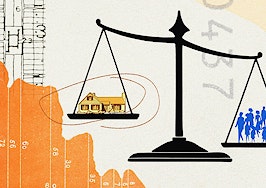We’ll add more market news briefs throughout the day. Check back to read the latest.
Most recent market news
Freddie Mac Primary Mortgage Market Survey
- 30-year fixed-rate mortgage (FRM) averaged 4.46 percent with an average 0.5 point for the week ending March 8, 2018, up from last week when it averaged 4.43 percent. A year ago at this time, the 30-year FRM averaged 4.21 percent.
- 15-year FRM this week averaged 3.94 percent with an average 0.5 point, up from last week when it averaged 3.90 percent. A year ago at this time, the 15-year FRM averaged 3.42 percent.
- 5-year Treasury-indexed hybrid adjustable-rate mortgage (ARM) averaged 3.63 percent this week with an average 0.4 point, up from last week when it averaged 3.62. A year ago at this time, the 5-year ARM averaged 3.23 percent.

Len Kiefer, deputy chief economist at Freddie Mac said:
“The 10-year Treasury yield has been bouncing around in a narrow 15 basis point range for the last month. While the yield on the 10-year Treasury is currently below the high of 2.95 percent reached two weeks ago, mortgage rates are up for the ninth consecutive week. The U.S. weekly average 30-year fixed mortgage rate rose 3 basis points to 4.46 percent in this week’s survey, its highest level since January 2014.”
- The 30-year fixed mortgage rate on Zillow® Mortgages is currently 4.29 percent, up one basis point from this time last week.
- The 30-year fixed mortgage rate fell to about 4.20 late last week, and then climbed steadily throughout the week to the current rate.
- The rate for a 15-year fixed home loan is currently 3.72 percent, and the rate for a 5-1 adjustable-rate mortgage (ARM) is 3.67 percent.
- The rate for a jumbo 30-year fixed loan is 4.40 percent.

Current rates for 30-year fixed mortgages by state. Source: Zillow
“Mortgage rates eased last Thursday after Federal Reserve Chair Jerome Powell appeared to soften earlier statements about his expectations for interest rates this year, but moved higher as geopolitical uncertainty seized the headlines,” said Aaron Terrazas, senior economist at Zillow.
“Markets could be particularly volatile over the next couple of days as the tenor of U.S. economic and trade policy gets worked out, but eyes will still be watching Friday’s jobs report, although to a lesser extent.”
Mortgage Bankers Association (MBA) Mortgage Credit Availability Index (MCAI)
- The MCAI decreased 1.2 percent to 180.7 in February. A decline in the MCAI indicates that lending standards are tightening, while increases in the index are indicative of loosening credit. The index was benchmarked to 100 in March 2012.
- The Conventional MCAI fell by more (down 2.5 percent) than the Government MCAI (down 0.2 percent). The component indices of the Conventional MCAI both decreased from the month prior, with the Jumbo MCAI falling by more (down 2.8 percent) than the Conforming MCAI (down 2.1 percent).
- The MCAI decreased 1.2 percent to 180.7 in February. The Conventional MCAI fell by more (down 2.5 percent) than the Government MCAI (down 0.2 percent).
- The component indices of the Conventional MCAI both decreased from the month prior, with the Jumbo MCAI falling by more (down 2.8 percent) than the Conforming MCAI (down 2.1 percent).

Source: Mortgage Bankers Association; Powered by Ellie Mae’s AllRegs Market Clarity
“Credit availability fell in February by 1.2 percent, led downwards by a decline in conventional offerings,” said Lynn Fisher, MBA’s vice president of research and economics. “A change in program offerings from a single large investor in the conventional space was responsible for much of the net decline.
“The decline in February returned the jumbo component index to levels just above year-end levels, and the conforming component index to levels just above last October. The government component index continued along the same modest downward trajectory that it has been on for nearly a year.”
News from earlier this week
Tuesday, March 6
Mortgage Bankers Association’s (MBA) Commercial/Multifamily Delinquency Report
- Delinquency rates for commercial and multifamily mortgage loans were relatively flat in the fourth quarter of 2017, according to the Mortgage Bankers Association’s (MBA) Commercial/Multifamily Delinquency Report.
- The MBA analysis looks at commercial/multifamily delinquency rates for five of the largest investor-groups: commercial banks and thrifts, commercial mortgage-backed securities (CMBS), life insurance companies, Fannie Mae, and Freddie Mac. Together these groups hold more than 80 percent of commercial/multifamily mortgage debt outstanding.
Based on the unpaid principal balance (UPB) of loans, delinquency rates for each group at the end of the fourth quarter were as follows:
- Banks and thrifts (90 or more days delinquent or in non-accrual): 0.51 percent, a decrease of 0.02 percentage points from the third quarter of 2017;
- Life company portfolios (60 or more days delinquent): 0.03 percent, an increase of 0.01 percentage points from the third quarter of 2017;
- Fannie Mae (60 or more days delinquent): 0.11 percent, an increase of 0.08 percentage points from the third quarter of 2017;
- Freddie Mac (60 or more days delinquent): 0.02 percent, unchanged from the third quarter of 2017;
- CMBS (30 or more days delinquent or in REO): 4.08 percent, a decrease of 0.52 percentage points from the third quarter of 2017;
“Commercial and multifamily mortgages ended 2017 continuing to perform extraordinarily well,” said Jamie Woodwell, MBA’s vice president of commercial real estate research. “The market tailwinds of strong fundamentals, increasing property values and ready access to mortgage and other credit all put downward pressure on delinquency rates.”
CoreLogic Home Price Insights — January 2018
- Home prices nationwide, including distressed sales, increased year over year by 6.6 percent in January 2018 compared with January 2017 and increased month over month by 0.5 percent in January 2018 compared with December 2017 (revisions with public records data are standard, and to ensure accuracy, CoreLogic incorporates the newly released public data to provide updated results).
- The CoreLogic HPI Forecast indicates that home prices will increase by 4.8 percent on a year-over-year basis from January 2018 to January 2019, and on a month-over-month basis home prices are expected to be flat from January 2018 to February 2018.
- Nationally, the year over year home price changed by 6.6 percent. All states experienced increases this month.
- The states with the highest increases January were: Washington (12.1 percent), Nevada (11.3 percent), Utah (10.8 percent) and Idaho (10.3 percent) all experiencing double digit increases.

Source: CoreLogic
“Entry-level homes have been in particularly short supply, leading to more rapid home-price growth compared with more expensive homes,” said CoreLogic chief economist Dr. Frank Nothaft in a statement. “Homes with a purchase price less than 75 percent of the local area median had price growth of 9.0 percent during the year ending January 2018.”
“Homes that sold for more than 125 percent of median appreciated 5.3 percent over the same 12-month period. Thus, first-time buyers are facing acute affordability challenges in some high-cost areas.”
Monday, March 5
- The 30-year fixed mortgage rate on Bankrate.com is currently 4.30 percent — up slightly from 4.28 percent last Friday.
- The 15-year fixed mortgage rate is currently 3.75 percent — up slightly from 3.72 percent last Friday.

Source: Bankrate








